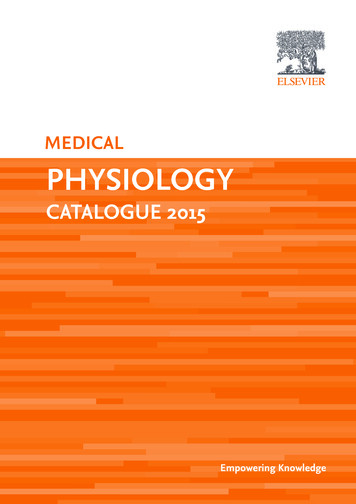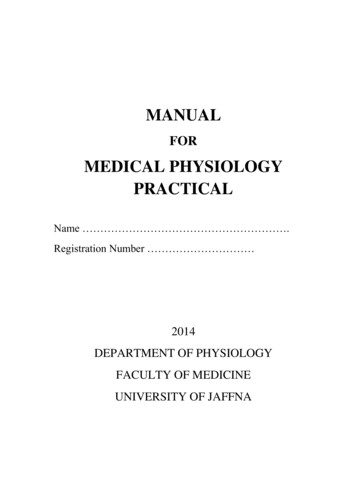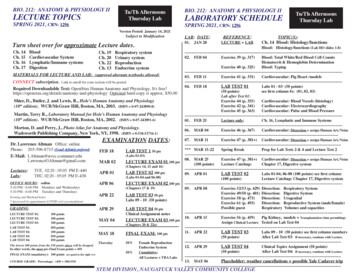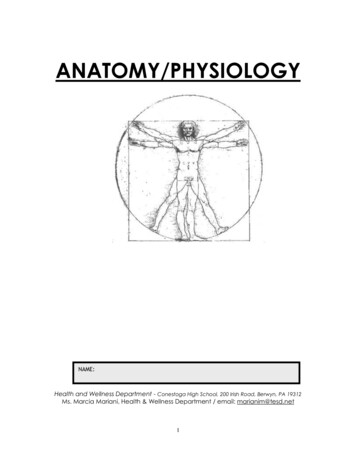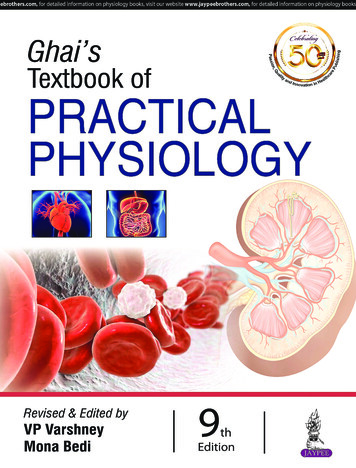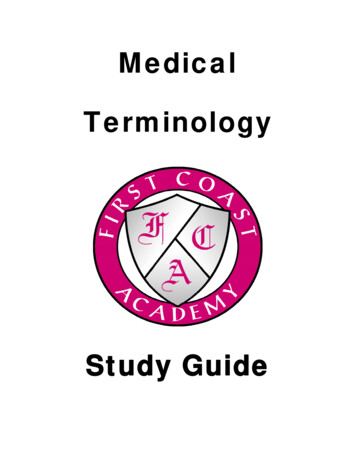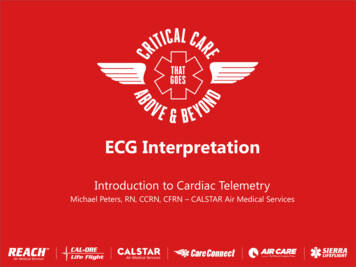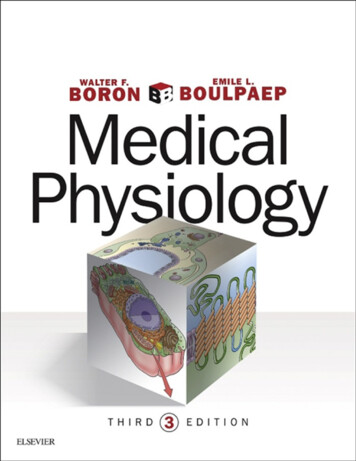
Transcription
Medical PhysiologyTHIRDEDITIONWALTER F. BORON, MD, PhDProfessorDavid N. and Inez Myers/Antonio Scarpa ChairmanDepartment of Physiology and BiophysicsCase Western Reserve UniversityCleveland, OhioEMILE L. BOULPAEP, MDProfessorDepartment of Cellular and Molecular PhysiologyYale University School of MedicineNew Haven, Connecticut
Table of ContentsInstructions for online accessCover imageTitle PageCopyrightContributorsVideo Table of ContentsPreface to the Third EditionThe eBookAcknowledgmentsPreface to the First EditionTarget AudienceContent of the TextbookEmphasis of the TextbookCreating the Textbook
Special FeaturesAcknowledgmentsSection I IntroductionChapter 1 Foundations of PhysiologyReferencesSection II Physiology of Cells and MoleculesChapter 2 Functional Organization of the CellStructure of Biological MembranesFunction of Membrane ProteinsCellular Organelles and the CytoskeletonSynthesis and Recycling of Membrane ProteinsSpecialized Cell TypesReferencesChapter 3 Signal TransductionMechanisms of Cellular CommunicationReceptors That are Ion ChannelsReceptors Coupled to G ProteinsReceptors That are CatalyticNuclear ReceptorsReferences
Chapter 4 Regulation of Gene ExpressionFrom Genes to ProteinsThe Promoter and Regulatory ElementsTranscription FactorsRegulation of Inducible Gene Expression by Signal-Transduction PathwaysEpigenetic Regulation of Gene ExpressionPost-Translational Regulation of Gene ExpressionReferencesGlossaryChapter 5 Transport of Solutes and WaterThe Intracellular and Extracellular FluidsSolute Transport Across Cell MembranesRegulation of Intracellular Ion ConcentrationsWater Transport and the Regulation of Cell VolumeTransport of Solutes and Water Across EpitheliaReferencesChapter 6 Electrophysiology of the Cell MembraneIonic Basis of Membrane PotentialsElectrical Model of a Cell MembraneMolecular Physiology of Ion ChannelsReferencesChapter 7 Electrical Excitability and Action PotentialsMechanisms of Nerve and Muscle Action Potentials
Physiology of Voltage-Gated Channels and Their RelativesPropagation of Action PotentialsReferencesChapter 8 Synaptic Transmission and the Neuromuscular JunctionMechanisms of Synaptic TransmissionSynaptic Transmission at the Neuromuscular JunctionToxins and Drugs Affecting Synaptic TransmissionReferencesChapter 9 Cellular Physiology of Skeletal, Cardiac, and Smooth MuscleSkeletal MuscleCardiac MuscleSmooth MuscleDiversity among MusclesReferencesSection III The Nervous SystemChapter 10 Organization of the Nervous SystemCells of the Nervous SystemDevelopment of Neurons and Glial CellsSubdivisions of the Nervous SystemReferencesChapter 11 The Neuronal Microenvironment
Cerebrospinal FluidBrain Extracellular SpaceThe Blood-Brain BarrierGlial CellsReferencesChapter 12 Physiology of NeuronsSignal Conduction in DendritesControl of Spiking Patterns in the SomaAxonal ConductionReferencesChapter 13 Synaptic Transmission in the Nervous SystemNeuronal SynapsesNeurotransmitter Systems of the BrainFast Amino Acid–Mediated Synapses in the CNSPlasticity of Central SynapsesReferencesChapter 14 The Autonomic Nervous SystemOrganization of the Visceral Control SystemSynaptic Physiology of the Autonomic Nervous SystemCentral Nervous System Control of the VisceraReferencesChapter 15 Sensory TransductionChemoreception
Visual TransductionVestibular and Auditory Transduction: Hair CellsSomatic Sensory Receptors, Proprioception, and PainReferencesChapter 16 Circuits of the Central Nervous SystemElements of Neural CircuitsSimple, Stereotyped Responses: Spinal Reflex CircuitsRhythmic Activity: Central Pattern GeneratorsSpatial Representations: Sensory and Motor Maps in the BrainTemporal Representations: Time-Measuring CircuitsReferencesSection IV The Cardiovascular SystemChapter 17 Organization of the Cardiovascular SystemElements of the Cardiovascular SystemHemodynamicsHow Blood FlowsOrigins of Pressure in the CirculationHow to Measure Blood Pressure, Blood Flow, and Cardiac VolumesReferencesChapter 18 BloodBlood CompositionBlood Viscosity
Hemostasis and FibrinolysisReferencesChapter 19 Arteries and VeinsArterial Distribution and Venous Collection SystemsElastic Properties of Blood VesselsReferencesChapter 20 The MicrocirculationCapillary Exchange of SolutesCapillary Exchange of WaterLymphaticsRegulation of the MicrocirculationReferencesChapter 21 Cardiac Electrophysiology and the ElectrocardiogramElectrophysiology of Cardiac CellsThe ElectrocardiogramCardiac ArrhythmiasReferencesChapter 22 The Heart as a PumpThe Cardiac CycleCardiac DynamicsFrom Contractile Filaments to a Regulated PumpReferencesChapter 23 Regulation of Arterial Pressure and Cardiac Output
Short-Term Regulation of Arterial PressureRegulation of Cardiac OutputMatching of Venous Return and Cardiac OutputIntermediate- and Long-Term Control of the CirculationReferencesChapter 24 Special CirculationsThe BrainThe HeartThe Skeletal MuscleThe Splanchnic OrgansThe SkinReferencesChapter 25 Integrated Control of the Cardiovascular SystemInteraction among the Different Cardiovascular Control SystemsResponse to Erect PostureResponses to Acute Emotional StressResponse to ExerciseResponse to HemorrhageReferencesSection V The Respiratory SystemChapter 26 Organization of the Respiratory SystemComparative Physiology of Respiration
Organization of the Respiratory System in HumansLung Volumes and CapacitiesReferencesChapter 27 Mechanics of VentilationStatic Properties of the LungDynamic Properties of the LungReferencesChapter 28 Acid-Base PhysiologypH and BuffersAcid-Base Chemistry When Is the Only BufferAcid-Base Chemistry in the Presence of and Buffers—The Davenport DiagrampH Regulation of Intracellular FluidReferencesChapter 29 Transport of Oxygen and Carbon Dioxide in the BloodCarriage of O2Carriage of CO2ReferencesChapter 30 Gas Exchange in the LungsDiffusion of GasesDiffusion and Perfusion Limitations on Gas TransportReferencesChapter 31 Ventilation and Perfusion of the Lungs
VentilationPerfusion of the LungMatching Ventilation and PerfusionReferencesChapter 32 Control of VentilationOverview of the Respiratory Control SystemNeurons That Control VentilationGeneration of the Respiratory RhythmChemical Control of VentilationModulation of Ventilatory ControlReferencesSection VI The Urinary SystemChapter 33 Organization of the Urinary SystemFunctional Anatomy of the KidneyMain Elements of Renal FunctionMeasuring Renal Clearance and TransportThe Ureters and BladderReferencesChapter 34 Glomerular Filtration and Renal Blood FlowGlomerular FiltrationRenal Blood FlowControl of Renal Blood Flow and Glomerular Filtration
ReferencesChapter 35 Transport of Sodium and ChlorideNa and Cl Transport by Different Segments of The NephronNa and Cl , and Water Transport at the Cellular and Molecular LevelRegulation of Na and Cl TransportReferencesChapter 36 Transport of Urea, Glucose, Phosphate, Calcium, Magnesium,and Organic SolutesUreaGlucoseOther Organic SolutesPhosphateCalciumMagnesiumReferencesChapter 37 Transport of PotassiumPotassium Balance and the Overall Renal Handling of PotassiumPotassium Transport by Different Segments of the NephronPotassium Transport at the Cellular and Molecular LevelsRegulation of Renal Potassium ExcretionReferencesChapter 38 Urine Concentration and DilutionWater Balance and the Overall Renal Handling of Water
Water Transport by Different Segments of the NephronGeneration of a Hyperosmotic Medulla and UrineRegulation by Arginine VasopressinReferencesChapter 39 Transport of Acids and BasesAcid-Base Balance and the Overall Renal Handling of AcidAcid-Base Transport by Different Segments of the NephronAcid-Base Transport at the Cellular and Molecular LevelsRegulation of Renal Acid SecretionReferencesChapter 40 Integration of Salt and Water BalanceControl of Extracellular Fluid VolumeControl of Water Content (Extracellular Osmolality)ReferencesSection VII The Gastrointestinal SystemChapter 41 Organization of the Gastrointestinal SystemOverview of Digestive ProcessesRegulation of Gastrointestinal FunctionGastrointestinal MotilityReferencesChapter 42 Gastric Function
Functional Anatomy of the StomachAcid SecretionPepsinogen SecretionProtection of the Gastric Surface Epithelium and Neutralization of Acid in the DuodenumFilling and Emptying of the StomachReferencesChapter 43 Pancreatic and Salivary GlandsOverview of Exocrine Gland PhysiologyPancreatic Acinar CellPancreatic Duct CellComposition, Function, and Control of Pancreatic SecretionSalivary Acinar CellSalivary Duct CellComposition, Function, and Control of Salivary SecretionReferencesChapter 44 Intestinal Fluid and Electrolyte MovementFunctional AnatomyOverview of Fluid and Electrolyte Movement in the IntestinesCellular Mechanisms of Na AbsorptionCellular Mechanisms of Cl Absorption and SecretionCellular Mechanisms of K Absorption and SecretionRegulation of Intestinal Ion TransportReferencesChapter 45 Nutrient Digestion and Absorption
Carbohydrate DigestionCarbohydrate AbsorptionProtein DigestionProtein, Peptide, and Amino-Acid AbsorptionLipid DigestionLipid AbsorptionDigestion and Absorption of Vitamins and MineralsNutritional RequirementsReferencesChapter 46 Hepatobiliary FunctionOverview of Liver PhysiologyFunctional Anatomy of the Liver and Biliary TreeUptake, Processing, and Secretion of Compounds by HepatocytesBile FormationEnterohepatic Circulation of Bile AcidsThe Liver as a Metabolic OrganReferencesSection VIII The Endocrine SystemChapter 47 Organization of Endocrine ControlPrinciples of Endocrine FunctionPeptide HormonesAmine HormonesSteroid and Thyroid Hormones
ReferencesChapter 48 Endocrine Regulation of Growth and Body MassGrowth HormoneGrowth-Promoting HormonesRegulation of Body MassReferencesChapter 49 The Thyroid GlandSynthesis of Thyroid HormonesAction of Thyroid HormonesHypothalamic-Pituitary-Thyroid AxisReferencesChapter 50 The Adrenal GlandThe Adrenal Cortex: CortisolThe Adrenal Cortex: AldosteroneThe Adrenal MedullaReferencesChapter 51 The Endocrine er 52 The Parathyroid Glands and Vitamin DCalcium and Phosphate Balance
Physiology of BoneParathyroid HormoneVitamin DCalcitonin and Other HormonesReferencesSection IX The Reproductive SystemChapter 53 Sexual DifferentiationGenetic Aspects of Sexual DifferentiationDifferentiation of the GonadsDevelopment of the Accessory Sex OrgansDifferentiation of the External GenitaliaEndocrine and Paracrine Control of Sexual DifferentiationPubertyReferencesChapter 54 The Male Reproductive SystemHypothalamic-Pituitary-Gonadal AxisTestosteroneBiology of Spermatogenesis and SemenMale Sex ActReferencesChapter 55 The Female Reproductive SystemHypothalamic-Pituitary-Gonadal Axis and Control of the Menstrual Cycle
Ovarian SteroidsThe Ovarian Cycle: Folliculogenesis, Ovulation, and Formation of the Corpus LuteumThe Endometrial CycleFemale Sex ActMenopauseReferencesChapter 56 Fertilization, Pregnancy, and LactationTransport of Gametes and FertilizationImplantation of the Developing EmbryoPhysiology of the PlacentaThe Maternal-Placental-Fetal UnitResponse of the Mother to PregnancyParturitionLactationReferencesChapter 57 Fetal and Neonatal PhysiologyBiology of Fetal GrowthDevelopment and Maturation of the Cardiopulmonary SystemCardiopulmonary Adjustments at BirthNeonatal PhysiologyReferencesSection X Physiology of Everyday Life
Chapter 58 MetabolismForms of EnergyEnergy BalanceEnergy Interconversion From Cycling between 6-Carbon and 3-Carbon MoleculesEnergy Capture (Anabolism)Energy Liberation (Catabolism)Integrative Metabolism During FastingReferencesChapter 59 Regulation of Body TemperatureHeat and Temperature: Advantages of HomeothermyModes of Heat TransferActive Regulation of Body Temperature by the Central Nervous SystemHypothermia, Hyperthermia, and FeverReferencesChapter 60 Exercise Physiology and Sports ScienceMotor Units and Muscle FunctionConversion of Chemical Energy to Mechanical WorkMuscle FatigueDeterminants of Maximal O2 Uptake and ConsumptionSweatingEndurance (Aerobic) TrainingReferencesChapter 61 Environmental PhysiologyThe Environment
Diving PhysiologyHigh-Altitude PhysiologyFlight and Space PhysiologyReferencesChapter 62 The Physiology of AgingConcepts in AgingCellular and Molecular Mechanisms of AgingAging of the Human Physiological SystemsAging SlowlyReferencesIndex
Copyright1600 John F. Kennedy Blvd.Ste 1800Philadelphia, PA 19103-2899MEDICAL PHYSIOLOGY, THIRD EDITIONISBN: 978-1-4557-4377-3INTERNATIONAL EDITIONISBN: 978-0-323-42796-8Copyright 2017 by Elsevier, Inc. All rights reserved.No part of this publication may be reproduced or transmitted in anyform or by any means, electronic or mechanical, including photocopying,recording, or any information storage and retrieval system, withoutpermission in writing from the publisher. Details on how to seekpermission, further information about the Publisher's permissionspolicies and our arrangements with organizations such as the CopyrightClearance Center and the Copyright Licensing Agency, can be found atour website: www.elsevier.com/permissions.This book and the individual contributions contained in it are protectedunder copyright by the Publisher (other than as may be noted herein).NoticesKnowledge and best practice in this field are constantly changing. Asnew research and experience broaden our understanding, changes inresearch methods, professional practices, or medical treatment maybecome necessary.
Practitioners and researchers must always rely on their own experienceand knowledge in evaluating and using any information, methods,compounds, or experiments described herein. In using such informationor methods they should be mindful of their own safety and the safety ofothers, including parties for whom they have a professionalresponsibility.With respect to any drug or pharmaceutical products identified, readersare advised to check the most current information provided (i) onprocedures featured or (ii) by the manufacturer of each product to beadministered, to verify the recommended dose or formula, the methodand duration of administration, and contraindications. It is theresponsibility of practitioners, relying on their own experience andknowledge of their patients, to make diagnoses, to determine dosagesand the best treatment for each individual patient, and to take allappropriate safety precautions.To the fullest extent of the law, neither the Publisher nor the authors,contributors, or editors, assume any liability for any injury and/ordamage to persons or property as a matter of products liability,negligence or otherwise, or from any use or operation of any methods,products, instructions, or ideas contained in the material herein.Previous editions copyrighted 2012, 2009, 2005, and 2003.Library of Congress Cataloging-in-Publication DataNames: Boron, Walter F., editor. Boulpaep, Emile L., editor.Title: Medical physiology / [edited by] Walter F. Boron, Emile L.Boulpaep.Other titles: Medical physiology (Boron)Description: Edition 3. Philadelphia, PA : Elsevier, [2017] Includesbibliographical references and index.Identifiers: LCCN 2016005260 ISBN 9781455743773 (hardcover : alk.paper) ISBN 9780323427968 (International ed.)Subjects: MESH: Physiological Phenomena Cell PhysiologicalPhenomenaClassification: LCC QP34.5 NLM QT 104 DDC 612—dc23 LC recordavailable at http://lccn.loc.gov/2016005260
Executive Content Strategist: Elyse O'GradySenior Content Development Specialist: Marybeth ThielPublishing Services Manager: Julie EddySenior Project Manager: David SteinDesign Direction: Julia DummittPrinted in ChinaLast digit is the print number:98 76 5 43 21
ContributorsPeter S. Aronson MDC.N.H. Long Professor of Internal MedicineProfessor of Cellular and Molecular PhysiologySection of NephrologyDepartment of Internal MedicineYale University School of MedicineNew Haven, ConnecticutEugene J. Barrett MD, PhDProfessorDepartments of Medicine and PharmacologyUniversity of Virginia School of MedicineCharlottesville, VirginiaPaula Q. Barrett PhDProfessorDepartment of PharmacologyUniversity of Virginia School of MedicineCharlottesville, VirginiaHenry J. Binder MDProfessor Emeritus of MedicineDepartment of Internal Medicine—Digestive DiseasesYale University School of MedicineNew Haven, ConnecticutWalter F. Boron MD, PhDProfessorDavid N. and Inez Myers/Antonio Scarpa ChairmanDepartment of Physiology and Biophysics
Case Western Reserve UniversityCleveland, OhioEmile L. Boulpaep MDProfessorDepartment of Cellular and Molecular PhysiologyYale University School of MedicineNew Haven, ConnecticutLloyd Cantley MD, FASNProfessorDepartment of Internal MedicineDepartment of Cellular and Molecular PhysiologyYale University School of MedicineNew Haven, ConnecticutMichael J. Caplan MD, PhDC.N.H. Long Professor and ChairDepartment of Cellular and Molecular PhysiologyYale University School of MedicineNew Haven, ConnecticutBarry W. Connors PhDProfessor and ChairDepartment of NeuroscienceAlpert Medical SchoolBrown UniversityProvidence, Rhode IslandArthur DuBois MDProfessor Emeritus of Epidemiology and Public Health and Cellular andMolecular PhysiologyJohn B. Pierce LaboratoryNew Haven, ConnecticutGerhard Giebisch MDProfessor Emeritus of Cellular and Molecular PhysiologyDepartment of Cellular and Molecular Physiology
Yale University School of MedicineNew Haven, ConnecticutFred S. Gorelick MDProfessorDepartments of Internal Medicine and Cell BiologyYale University School of MedicineNew Haven, ConnecticutPeter Igarashi MDNesbitt Chair and HeadDepartment of MedicineUniversity of MinnesotaMinneapolis, MinnesotaErvin E. Jones MD, PhDRetiredDepartment of Obstetrics and GynecologyYale University School of MedicineNew Haven, ConnecticutW. Jonathan Lederer MD, PhDDirector and Professor, Center for Biomedical Engineering andTechnology and Department of PhysiologyUniversity of Maryland School of MedicineBaltimore, MarylandGeorge Lister MDJean McLean Wallace Professor of PediatricsProfessor of Cellular and Molecular PhysiologyYale School of MedicineNew Haven, ConnecticutCharles M. Mansbach II, MD †Professor of Medicine and PhysiologyUniversity of Tennessee Health Science CenterMemphis, Tennessee
Christopher R. Marino MDProfessor of MedicineUniversity of Tennessee Health Science CenterChief of StaffVA Medical CenterMemphis, TennesseeEdward J. Masoro PhDProfessor Emeritus of PhysiologyUniversity of Texas Health Science Center at San AntonioSan Antonio, TexasSam Mesiano PhDProfessorDepartment of Reproductive BiologyCase Western Reserve UniversityCleveland, OhioEdward G. Moczydlowski PhDSenior Associate Dean of Academic Affairs & Professor of PhysiologyCollege of Health SciencesCalifornia Northstate UniversityElk Grove, CaliforniaShaun F. Morrison PhDProfessorDepartment of Neurological SurgeryOregon Health & Science UniversityPortland, OregonKitt Falk Petersen MDProfessorSection of EndocrinologyDepartment of Internal MedicineYale University School of MedicineNew Haven, ConnecticutBruce R. Ransom MD, PhD
Magnuson Professor and ChairDepartment of NeurologyDepartment of Physiology and BiophysicsUniversity of Washington Health Sciences CenterSeattle, WashingtonGeorge B. Richerson MD, PhDProfessor & ChairmanDepartment of NeurologyUniversity of Iowa Carver College of MedicineIowa City, IowaSteven S. Segal PhDProfessorDepartment of Medical Pharmacology and PhysiologyUniversity of Missouri School of MedicineColumbia, MissouriGerald I. Shulman MD, PhD, FACP, MACEInvestigator, Howard Hughes Medical InstituteGeorge R. Cowgill Professor of Physiological ChemistryProfessor of Medicine (Endocrinology/Metabolism) and Cellular &Molecular PhysiologyCo-Director, Yale Diabetes Research CenterYale University School of MedicineNew Haven, ConnecticutFrederick J. Suchy MDChief Research OfficerDirector, Children's Hospital Colorado Research InstituteProfessor of PediatricsAssociate Dean for Child Health ResearchUniversity of Colorado School of MedicineAurora, ColoradoErich E. Windhager MDProfessorDepartment of Physiology and Biophysics
Weill Medical CollegeCornell UniversityNew York, New York†Deceased.
Video Table of Contents7-1 Action Potential8-1 Chemical Synaptic Transmission9-1 The Cross Bridge Cycle10-1 Chemotaxis13-1 Chemical Synaptic Transmission22-1 The Cardiac Cycle27-1 Pressures during Respiration38-1 The Countercurrent Multiplier41-1 Peristalsis55-1 The Menstrual Cycle
Preface to the Third EditionWe are delighted that the physiological community so eagerly welcomedthe Second Edition of our book. The 3-fold philosophy that has guided usin the previous editions has endured as we prepared the Third Edition.First, we combine the expertise of several authors with the consistencyof a single pen. In the First Edition, we achieved this singleness of pen bysitting—shoulder to shoulder—at a computer as we rewrote the primarycopy of our authors, line by line. By the time we began editing the ThirdEdition, one of us had moved from New Haven to Cleveland. Even so,we continued to edit jointly and in real time—monitor to monitor—usingdesktop-sharing software. After more than two decades, we have becomeso accustomed to each other's writing styles that we can literally finisheach other's sentences.Second, we still integrate physiological concepts from the level of DNAand epigenetics to the human body, and everything in between.Third, we complete the presentation of important physiologicalprinciples by pairing them with illustrations from pathophysiology,thereby putting physiology in a clinical context.In this Third Edition, we have updated the entire book to reflect newmolecular insights. In the process, we have shortened the printed versionof the book by 40 pages. The Third Edition contains 20 new or redrawnfigures as well as enhancements to 125 others. Similarly, we includedover 190 tables. In the First Edition, we launched the concept of onlineonly Notes—electronic footnotes that were available on the StudentConsult website. These Notes (indicated by icons in the print version ofthe book) amplify concepts in the text, provide details and derivations ofequations, add clinical illustrations, and include interesting facts (e.g.,biographies of famous physiologists). With the increased use of onlinematerials and eBooks, our readers may welcome our updating of theprevious Notes as well as a 13% increase in the total number of Notes forthe Third Edition, for a total of about 750. In the Second Edition, we
provided the reader with numerous crosslinks to explanatory materialswithin the book by providing chapter numbers. In the Third Edition, wegreatly expand the number of such crosslinks—but now refer the readerto specific pages in the print, and link the reader to specific paragraphs inthe eBook. The eBook provides references to scientific literature.In Section II (Physiology of Cells and Molecules), fresh insights led tosubstantial revisions in Chapter 4 (Regulation of Gene Expression),including the subchapter on epigenetics, and another onposttranslational modifications. Moreover, advances in physiologicalgenomics and the understanding of genetic diseases led to majorexpansions of two tables—one on the SLC family of transporters (Table5-4 in the chapter on Transport of Solutes and Water) and the other on ionchannels (Table 6-2 in the chapter on Electrophysiology of the CellMembrane). In both tables, our updates help the reader navigate throughwhat sometimes are multiple systems of terminology.In Section III (The Nervous System), new molecular developments ledto major changes in Chapter 15 (Sensory Transduction), including thetransduction of taste. In Section IV (The Cardiovascular System), we haveimproved the molecular underpinning of the ionic currents in Chapter 21(Cardiac Electrophysiology and the Electrocardiogram). In Section VI (TheUrinary System), we welcome Peter Aronson as a new co-author.Improved molecular insights led to major improvements in Chapter 36,including the subchapters on urea, urate, phosphate, and calcium. InSection VII (The Gastrointestinal System), Chapter 43 (Pancreatic andSalivary Glands) underwent significant modernization, including anexpansion of the treatment of salivary glands. In Chapter 45 (NutrientDigestion and Absorption), we welcome Charles Mansbach as a new coauthor. Section VIII (The Endocrine System) underwent significantupdating, including the treatment of phosphate handling in Chapter 52(The Parathyroid Glands and Vitamin D). In Section IX (The ReproductiveSystem), we welcome two new authors. Sam Mesiano extensivelyreworked Chapters 53 (Sexual Differentiation) through Chapter 56(Fertilization, Pregnancy, and Lactation), and George Lister has similarlyrewritten Chapter 57 (Fetal and Neonatal Physiology). Finally, in Section X(Physiology of Everyday Life), we welcome Shaun Morrison, whoextensively rewrote Chapter 59 (Regulation of Body Temperature). Chapter
62 (The Physiology of Aging) underwent extensive changes, including newtreatments of necroptosis and frailty.
The eBookAlthough you can still enjoy our book while reading the print version,you can also access the extended content at your computer via thewebsite www.StudentConsult.com. The eBook is also available throughthe Inkling app on tablets and smart phones. Regardless of the platformfor accessing the eBook, the student may access Notes, crosslinks, andreferences as noted above, and also can “follow” professors and see theirhighlights and annotations within the text.
AcknowledgmentsA textbook is the culmination of successful collaborations among manyindividuals. First, we thank our chapter authors, who are listed underContributors on pages v and vi. We also thank other colleagues whowrote WebNotes, or provided other valuable materials or input. RobertoDominguez provided Figure 9-5A, and Slavek Filipek and KrisPalczewski provided Figure 15-12. Philine Wangemann made invaluablesuggestions for the Vestibular and Auditory Transduction subchapter inChapter 15. George Dubyak responded to numerous queries. We thankall our readers who sent us their suggestions or corrections; we list themin the accompanying NP-1.NP-1List of Readers Who Made SuggestionsFacultyRaif Musa Aziz, PhD, Assistant Professor, Department of Physiologyand Biophysics, Institute of Biomedical Sciences, University of SaoPaulo, Sao Paulo, BrazilMark Borden, PhD, Associate Professor, University of ColoradoGerald DiBona, MD, Professor Emeritus of Medicine and MolecularPhysiology and Biophysics, Carver College of Medicine, University ofIowaRoberto Dominguez, PhD, Professor of Physiology, Perelman Schoolof Medicine, University of PennsylvaniaGeorge Dubyak, PhD, Professor, Department of Physiology andBiophysics, Case Western Reserve UniversityMikael Esmann, PhD, Professor of Physiology and Biophysics,Aarhus UniversitySlavek Filipek, PhD, Department of Pharmacology, School ofMedicine, Case Western Reserve UniversityGabriel Haddad, MD, Chairman of Pediatrics, University ofCalifornia—San DiegoUlrich Hopfer, MD, PhD, Professor Emeritus, Department of
Physiology and Biophysics, Case Western Reserve UniversityNorman Javitt, MD, PhD, Professor of Medicine and Pediatrics, NewYork University Medical CenterBhanu Jena, PhD, DSc, Professor of Physiology, School of Medicine,Wayne State UniversityStephen Jones, PhD, Professor, Department of Physiology andBiophysics, Case Western Reserve UniversityAlan Kay, PhD, Professor of Biology, University of IowaRossana Occhipinti, PhD, Department of Physiology and Biophysics,Case Western Reserve UniversityKrzysztof Palczewski, PhD, Professor and Chair, Department ofPharmacology, School of Medicine, Case Western Reserve UniversityMark Parker, PhD, Assistant Professor, Department of Physiologyand Biophysics, SUNY at BuffaloD. Narayan Rao, PhD, Department of Physiology, Faculty ofMedicine, Benghazi UniversityAndrea Romani, MD, PhD, Associate Professor, Department ofPhysiology and Biophysics, Case Western Reserve UniversityCorey Smith, PhD, Professor, Department of Physiology andBiophysics, Case Western Reserve UniversityJulian Stelzer, PhD, Assistant Professor, Department of Physiologyand Biophysics, Case Western Reserve UniversityFunabashi Toshiya, MD, PhD, Professor, Department of Physiology,St. Marianna University School of Medicine, Kawasaki, JapanPhiline Wangemann, PhD, University Distinguished Professor,Department of Anatomy & Physiology, Kansas State UniversityErnest Wright, PhD, Professor, David Geffen School of Medicine,University of California—Los AngelesStudentsNatthew ArunthamakunTaylor BurchTung ChuXiaoke FengClare FewtrellTrevor HallJeffery Jeong
Hani KhadraBob LeeShannon LiSarabjot MakkarClaire MillerPamela MooreheadAmalia NamathSarah SheldonSadia TahirEunji YimAt the art studio DNA Illustrations, Inc, we thank David and AlexBaker for developing new figures and updating others, whilemaintaining the textbook's aesthetic appeal, originally established by JBWoolsey and Associates.At Elsevier, we are most grateful to Elyse O'Grady—Executive ContentStrategist—for her trust and endurance. Marybeth Thiel—Senior ContentDevelopment Specialist—was the project's communications hub,responsible for coordinating all parties working on the textbook, and forassembling the many elements that comprised the final product. Hermeticulous care was indispensible. We thank David Stein—Senior ProjectManager—for overseeing production of the textbook. Striving forconsistency, Elsevier did us the favor of assigning a single copyeditor—Janet E. Lincoln—to the entire project. We were especially impressedwith her meticulous copyediting. Moreover, because she read themanuscript as a dedicated student, she identified several logical orscientific errors, including inconsistencies between chapters.Finally, we thank four editorial assistants. Charleen Be
Medical Physiology THIRD EDITION WALTER F. BORON, MD, PhD Professor David N. and Inez Myers/Antonio Scarpa Chairman Department of Physiology and Biophysics Case Western Reserve University Cleveland, Ohio EMILE L. BOULPAEP, MD Professor Department of Cellular and Molecular Physiology
